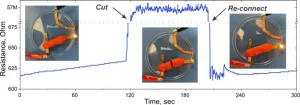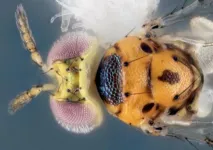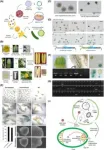(Press-News.org) As human population and development continue to expand, it’s more important than ever to set aside corridors of undeveloped land where wildlife can travel safely, helping to ensure their long-term survival. However, a recent study by the University of Maryland reveals that current methods of designing and evaluating wildlife corridors may not be adequate to ensure wildlife protection, and suggests that Best Management Practices should include analyzing corridors with a smarter and more thorough framework. University researchers tested different wildlife corridor designs against black bear movement data in Florida and found that each achieved very different results, and none captured all black bear movements. Additionally, their testing results varied widely depending on the evaluation method they used. The work highlights the complexity of the issues involved and shows that, while there is no one best method, the purpose of a corridor, which can vary widely, will directly impact what approaches should be considered to achieve conservation goals.
The study was published in September in the journal Landscape Ecology.
“If we don’t get these corridors right, our efforts at conservation will be wasted, and we could see more human-wildlife conflicts,” said Jennifer Mullinax, an associate professor in the Department of Environmental Science and Technology at UMD, and senior author of the study. “In Florida, black bear populations were once threatened, but have been rebounding, and continue to spread. Better methods are urgently needed, because it takes a lot of time to do it right, and in the case of endangered or threatened species, we could build corridors and still not provide protections for those animals.”
Creating corridors often means government agencies, municipalities, or non-profits purchase and protect expensive tracts of land or work with developers to conserve areas that might otherwise be developed. The tracts of land chosen for conservation are often determined by scientific modeling based on animal movements and landscape features. But the needs of different species in different locations are complex and not all corridors have the same goal. One may need to provide access to new habitats for an expanding population, and another may aim to improve genetic diversity by connecting populations that are separated by development.
In addition to these complexities, conserving wildlife corridors is expensive, and yet it remains unknown how different design methods influence their effectiveness, or how to evaluate if they are working for the intended purpose.
Mullinax and her team used three different mathematical models to create theoretical wildlife corridors for black bears in Florida and compared them to tracking data to determine how black bears actually move through the environment. They also compared their model corridors to the existing Florida Wildlife Corridor, a network of public and private conservation lands designated as a multi-species corridor across the state.
To develop potential corridors, the team combined information on bear habitats and where they are likely to live, with landscape features and information on how easy or difficult it is for bears to move through the environment. The study revealed how tricky it can be to define “easy movement” and then use it to develop corridor parameters. For example, traveling across open farm fields and roadways may be physically easier for a bear than traveling through dense woods, but that’s not where you want bears to go. While an urban area could be considered more difficult for a bear to traverse, some bears will waltz right through town to find the local trash dump that offers lots of food. Mullinax and her team developed three different approaches to defining “difficult movement” and created three gridded maps of Florida, each with different levels of “resistance” built into the landscape.
The team used a program called Circuitscape to combine their resistance grids with bear habitat information and developed maps showing the most likely flow of bear movement in Florida. It can be thought of as a sort of road map that shows multiple bear “roads” and “highways” with more or less likely bear traffic.
They used those maps to create three different potential corridors and overlaid them with GPS tracking data on the real movements of 30 bears, each of which had been intensively tracked for an extended period of time. The results were mixed, and how well any corridor did changed depending on bear behaviors.
For example, the corridor that had the least overlap with bear movements, and scored the lowest in most evaluations, was the only corridor that included the movements of a single unique bear that had a mind of his own.
“That’s what we call a dispersal movement, when an individual moves to a completely new location looking for a new home,” Mullinax explained. “If one bear does it, others may too, and it’s how animals establish themselves in new territories. That’s what we want to capture, but the best overall models completely failed to capture that unique bear movement.”
Additionally, what works for some animals may not work for all. The Florida Wildlife Corridor is considered a multi-species corridor that covers a large area, but it included fewer bears per square kilometer than the bear-specific model corridors the team designed.
The study challenges the often-raised idea that any wildlife corridor is always better than no corridor. According to Mullinax, it may be true that any conservation effort is better than none, but this work raises an urgent call for more research and more resources to ensure the expense and effort of building wildlife corridors does not go to waste, especially as we continue to experience shrinking wildlife habitats and a changing climate.
END
If you build it, will they come? Wildlife corridors need smarter design
UMD research finds effectiveness of wildlife corridors can vary widely
2024-09-18
ELSE PRESS RELEASES FROM THIS DATE:
Sea surface temperature record in the southwestern Pacific: Coral colony from Fiji reveals warmest temperatures in over 600 years
2024-09-18
The sea surface temperature in the Fijian archipelago in the southwestern Pacific is now at its maximum for more than 600 years. This is the result of an international research team's evaluation of a new coral record providing further evidence for unprecedented warming in the western Pacific Ocean. According to this, the year 2022 was the warmest year in the region since 1370. The scientists used the giant coral Diploastrea heliopora colony in Fiji to obtain the data for the new reconstruction. These unique and long-lived massive corals record long-term climatic and ...
Homemade ‘play-putty’ can read the body’s electric signals, find UMass researchers
2024-09-18
AMHERST, Mass. – A new study by University of Massachusetts Amherst researchers demonstrates the effectiveness of homemade play putty at reading brain, heart, muscle and eye activity. Published in Device, the research outlines the conductive properties of this material, so-named “squishy circuits.”
“[Squishy circuits] are literally child’s play putty, that is also conductive” describes Dmitry Kireev, assistant professor of biomedical engineering and senior author on the paper.
The conductive squishy ...
Magnifying deep space through the “carousel lens”
2024-09-18
In a rare and extraordinary discovery, researchers have identified a unique configuration of galaxies that form the most exquisitely aligned gravitational lens found to date. The Carousel Lens is a massive cluster-scale gravitational lens system that will enable researchers to delve deeper into the mysteries of the cosmos, including dark matter and dark energy.
“This is an amazingly lucky ‘galactic line-up’ – a chance alignment of multiple galaxies across a line-of-sight spanning most of the observable universe,” said David Schlegel, a co-author of the study and a senior scientist in Berkeley Lab’s Physics Division. "Finding one such alignment is ...
Another new wasp species discovered by researchers Rice campus
2024-09-18
A newly identified wasp species, Chrysonotomyia susbelli, has been discovered in Houston, Texas, marking the 18th new species identified by Rice University’s Scott Egan and his research team since 2014. The discovery, the fourth wasp species found on the university grounds in seven years, reveals the hidden world of parasitoid wasps and the intricate ecosystems that thrive outside our doors.
The Chrysonotomyia susbelli is a parasitoid wasp, about 1 millimeter long, that emerges from galls, or tumorlike growths created by the gall wasp Neuroterus bussae found on southern live oak leaves. The galls serve as microhabitats within which larvae feed, develop and pupate. ...
Greenhouse gains: cucumbers get a genetic upgrade through innovative pollen tech
2024-09-18
Researchers have achieved a groundbreaking advancement in plant biotechnology by using a magnetofected pollen gene delivery system to genetically transform cucumbers. This cutting-edge method uses DNA-coated magnetic nanoparticles to introduce foreign genes into pollen, producing genetically modified seeds without the need for traditional tissue culture or regeneration steps. This technique significantly streamlines and accelerates crop genetic modification, opening up new avenues to boost agricultural productivity and resilience.
Genetic modification in horticultural crops, particularly within the Cucurbitaceae family, is often hindered by complex tissue culture requirements and ...
Like humans, artificial minds can learn by thinking
2024-09-18
Some of the greatest discoveries don’t come merely from observations but from thinking. Einstein developed theories about relativity through thought experiments, and Galileo derived insights about gravity through mental simulations. A review published September 18 in the journal Trends in Cognitive Sciences shows that this process of thinking is not exclusive to humans. Artificial intelligence, too, is capable of self-correction and arriving at new conclusions through “learning by thinking.”
“There are some recent demonstrations of what looks like learning by thinking in AI, ...
Discarding the placenta after birth leads to loss of valuable information, pathologists say
2024-09-18
In an opinion article publishing September 18 in the Cell Press journal Trends in Molecular Medicine, physician-scientists argue that with most placentas discarded after birth, placental pathology is underutilized clinically, should be a routine part of obstetric and neonatal care, and also deserves more research attention.
“Placentas should not be considered a waste tissue,” says senior author Mana Parast, MD, PhD, professor of pathology at University of California San Diego School of Medicine. ...
Nonfatal opioid overdoses in youth spiked during pandemic
2024-09-18
Drug overdose mortality has risen faster among adolescents than the general population in recent years, largely due to fentanyl, a potent opioid pain medication. A new study published in JAMA sheds light on trends in nonfatal opioid overdoses in youth – an area that was not as well characterized, but key to formulating prevention strategies to save lives.
Researchers from Ann & Robert H. Lurie Children’s Hospital of Chicago and colleagues analyzed data using Emergency Medical Services (EMS) encounters from January 2018 to December 2022. They found that opioid overdoses in youth increased at pandemic onset and remained elevated compared to pre-pandemic levels. The majority ...
Characteristics and trends of prehospital encounters for opioid overdoses among US youth, 2018-2022
2024-09-18
About The Study: Prehospital encounters for youth opioid overdoses were increasing prior to the pandemic, increased with the onset, and then stabilized, remaining higher than pre-pandemic levels. Although overall patterns were largely driven by those ages 18 through 24, adolescents ages 12 through 17 were the only subgroup with an increasing number of encounters both before and during the pandemic.
Corresponding Author: To contact the corresponding author, Jamie Lim, MD, email jlim@luriechildrens.org.
To access the embargoed study: Visit our ...
Gargantuan black hole jets are biggest seen yet
2024-09-18
** Caltech is hosting an embargoed media zoom about this result on Monday, September 16 at 10am Pacific/1pm Eastern. You can register here:
https://caltech.zoom.us/webinar/register/WN_gYEV5Tl1S0uZkZG1gDIEnQ#/registration
Astronomers have spotted the biggest pair of black hole jets ever seen, spanning 23 million light-years in total length. That's equivalent to lining up 140 Milky Way galaxies back to back.
"This pair is not just the size of a solar system, or a Milky Way; we are talking about 140 Milky Way diameters in total," says Martijn ...
LAST 30 PRESS RELEASES:
American Meteorological Society announces new executive director
People with “binge-watching addiction” are more likely to be lonely
Wild potato follows a path to domestication in the American Southwest
General climate advocacy ad campaign received more public engagement compared to more-tailored ad campaign promoting sustainable fashion
Medical LLMs may show real-world potential in identifying individuals with major depressive disorder using WhatsApp voice note recordings
Early translational study supports the role of high-dose inhaled nitric oxide as a potential antimicrobial therapy
AI can predict preemies’ path, Stanford Medicine-led study shows
A wild potato that changed the story of agriculture in the American Southwest
Cancer’s super-enhancers may set the map for DNA breaks and repair: A key clue to why tumors become aggressive and genetically unstable
Prehistoric tool made from elephant bone is the oldest discovered in Europe
Mineralized dental plaque from the Iron Age provides insight into the diet of the Scythians
Salty facts: takeaways have more salt than labels claim
When scientists build nanoscale architecture to solve textile and pharmaceutical industry challenges
Massive cloud with metallic winds discovered orbiting mystery object
Old diseases return as settlement pushes into the Amazon rainforest
Takeaways are used to reward and console – study
Velocity gradients key to explaining large-scale magnetic field structure
Bird retinas function without oxygen – solving a centuries-old biological mystery
Pregnancy- and abortion-related mortality in the US, 2018-2021
Global burden of violence against transgender and gender-diverse adults
Generative AI use and depressive symptoms among US adults
Antibiotic therapy for uncomplicated acute appendicitis
Childhood ADHD linked to midlife physical health problems
Patients struggle to measure blood pressure at home
A new method to unlock vast lithium stores
Scientists unveil “dissolution barocaloric” cooling, opening new path to zero-carbon refrigeration
Microplastics in the atmosphere: Higher emissions from land areas than from the ocean
Metal clumps in quantum state: Vienna research team breaks records
PolyU develops new human-safe magnetorheological fibres, leading innovations in smart wearable textiles
Rice establishes Global Brain Economy Initiative in Davos, aligned with new report on brain health and AI
[Press-News.org] If you build it, will they come? Wildlife corridors need smarter designUMD research finds effectiveness of wildlife corridors can vary widely





